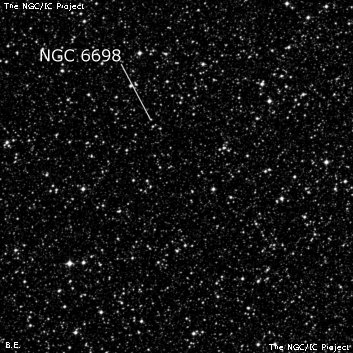NGC/IC Project Restoration Effort
(This is a very very beta version)
NGC6698


Basic Information
Location and Magnitude
Right Ascension: 18:48:18.0
Declination: -25:54:48
Constellation: SGR
Visual Magnitude:
Historic Information
Discoverer: Herschel W.
Year of discovery: 1784
Discovery aperture: 18.7
Observational
Summary description: Suspected Cl, cL, st vF
Sub-type: *Grp
Corwin's Notes
=====
NGC 6698 may be the somewhat denser region of stars about 25 arcmin north of
WH's position. If so, his position for it shares the same large offset that
affects his positions for N6514 and N6533 (which see), found the same night.
Another position can be derived by noting that WH's positions from this sweep
are generally poor, and are not internally consistent within the sweep. Here,
for example, are the positions for NGC 6698 and for M 22 (NGC 6656), the
cluster in the sweep observed just twelve minutes before NGC 6698, as derived
from four different stars in the sweep:
M 22 NGC 6698
Star RA (J2000) Dec RA (J2000) Dec
22 Sgr 18 36 51 -24 03.1 18 49 00 -25 52.1
25 Sgr 18 37 49 -24 01.3 18 49 59 -25 50.6
34 Sgr 18 36 10 -24 05.5 18 48 20 -25 54.7
42 Sgr 18 36 16 -23 57.3 18 48 26 -25 46.6
Modern 18 36 24 -23 54.3 [18 48 18 -25 43.5]
The mean values of WH's positions from these four stars for M 22 is 18 36 47,
-24 01.8. This implies offsets from the modern position of 23 seconds of time
and 7.5 arcminutes. Applying these to the mean position from the four stars
for NGC 6698 gives the position above in brackets. I don't see much there
that would suggest even a "suspected cluster", so am more drawn to the star
cloud of the first paragraph above.
If this is WH's object -- his description "A suspected cluster of vF stars of
considerable extent" certainly fits -- it is probably not a true cluster, but
just a concentration in the rich Milky Way field. There is a question of why
he included it in his 6th class, "Very compressed and rich clusters of stars."
The description perhaps better fits a cluster of his 8th class.
Coincidentally, the planetary nebula PK 009-10.1 is close to the center of the
concentration. The proper motions would have to be checked to see if there is
a connection, or indeed if there really is a cluster here.
-----
Brent Archinal in "Star Clusters" adopts WH's (the NGC) position and notes a
"Possibly [sic] 10' x 5' slight concentration of stars here?" This might be
a possibility, but I don't see much of anything here.
As with many of these scattered "clusters", we have more questions than
answers, and not enough data to make even reasonable guesses at
identifications.
Steve's Notes
=====
NGC 6698
18" (9/3/05): at 115x there was nothing notable at William Herschel's position. Harold Corwin suggests a denser grouping about 25' N and at this location there is a very scattered Milky Way field of stars, ~20'-25' in diameter, but this star field does not stand out at the eyepiece. In fact, the only object in the area that caught my eye was a small glowing 2' knot of stars at ~18 48.0 -25 43.7 (10' N of Herschel's position), though this knot doesn't match his description of "A suspected cluster of vF stars of considerable extent". At 225x, ~10 stars were resolved within 1.5'-2'. The planetary M3-33 (see description) is situated within the grouping observed 25' N of the NGC position. Listed as nonexistent in the RNGC.



